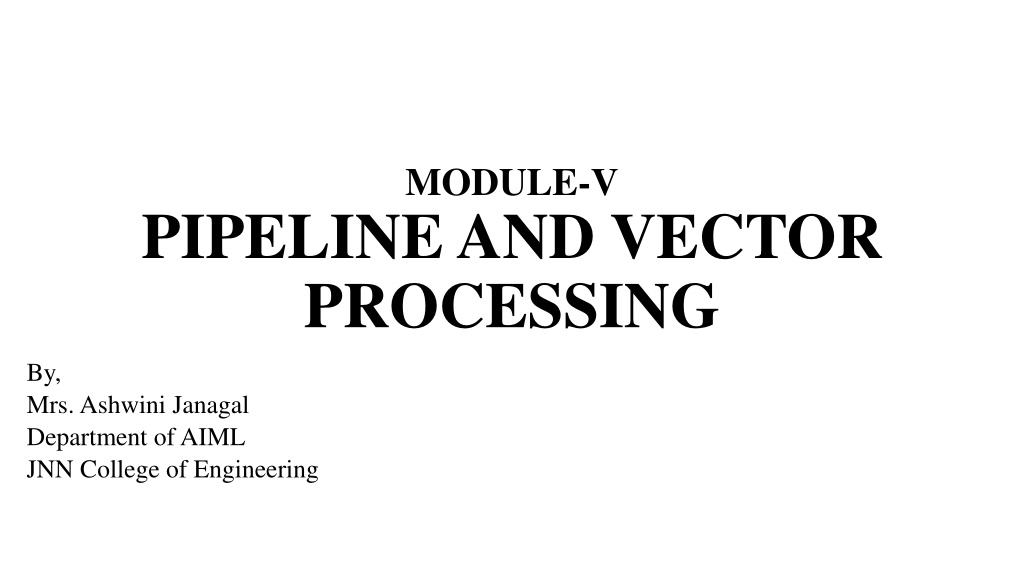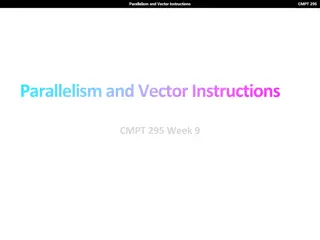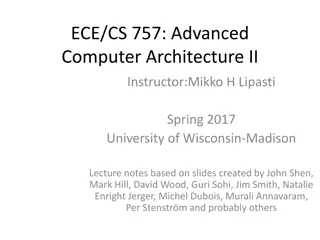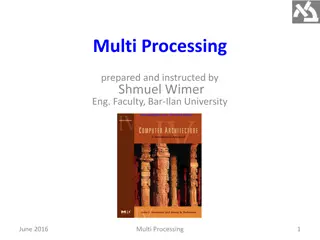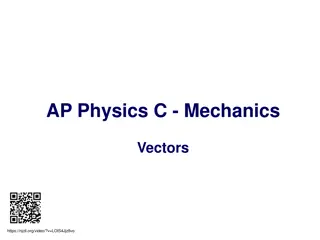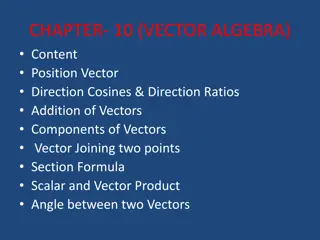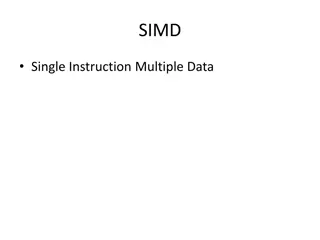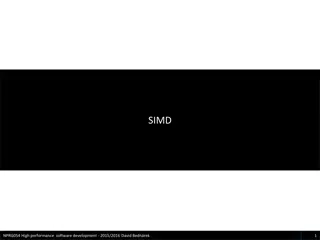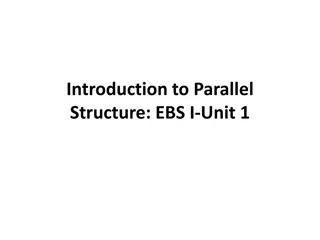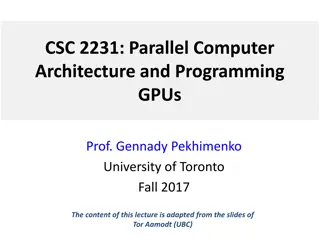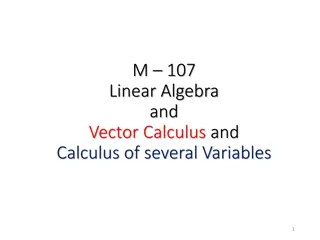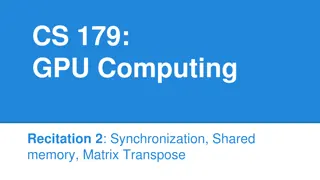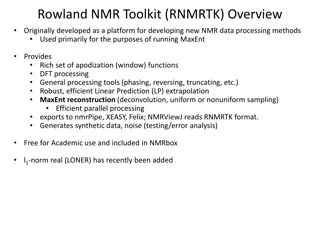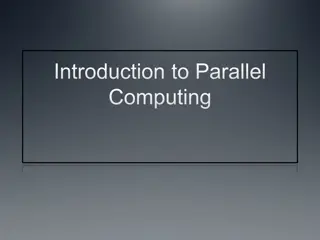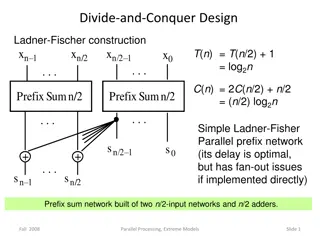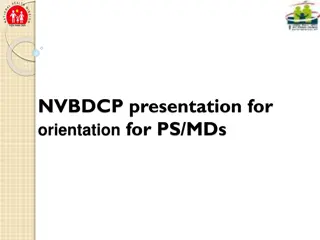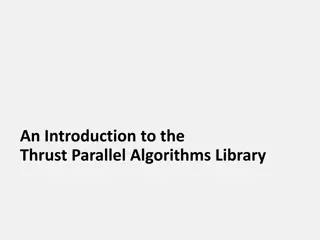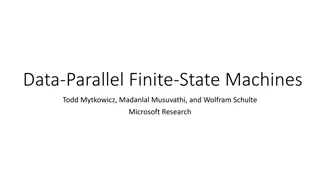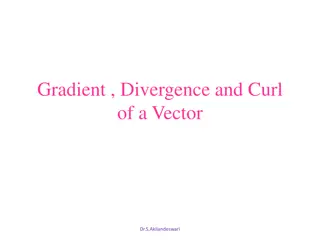Parallel and Vector Processing Techniques in Computer Systems
Understanding parallel and vector processing is essential for enhancing computational speed and throughput in computer systems. Parallel processing involves executing multiple tasks simultaneously to increase processing capability. Pipelining divides processes into sub-processes for efficient execution, especially beneficial for repetitive tasks. Mrs. Ashwini Janagal explains these concepts at JNN College of Engineering, providing insights into classification based on M. J. Flynn's taxonomy.
Download Presentation

Please find below an Image/Link to download the presentation.
The content on the website is provided AS IS for your information and personal use only. It may not be sold, licensed, or shared on other websites without obtaining consent from the author. Download presentation by click this link. If you encounter any issues during the download, it is possible that the publisher has removed the file from their server.
E N D
Presentation Transcript
MODULE-V PIPELINE AND VECTOR PROCESSING By, Mrs. Ashwini Janagal Department of AIML JNN College of Engineering
Parallel Processing Parallel processing is a term used to denote a large class of techniques that are used to provide simultaneous data-processing tasks for the purpose of increasing the computational speed of a computer system The purpose of parallel processing is to speed up the computer processing capability and increase its throughput, that i.s, the amount of processing that can be accomplished during a given interval of time.
Parallel Processing SEPARATE EACH EXECUTION UNIT SUCH THAT THEY CAN OPERATE IN PARALLEL
Parallel Processing Classification according to M. J. Flynn Single Instruction Single Data Single Instruction Multiple Data Multiple Instruction Single Data Multiple Instruction Multiple DAta
Pipelining Divide Sequential Process into Sub-process. Each subprocess belong to a segment And segments can be executed in parallel But there will be dependency between segments. Output from one segment will be the Input to other segment.
Pipelining Example
Pipelining Example
Pipelining Example
Pipelining The technique is efficient for those applications that need to repeat the same task many times with different sets of data.
Pipelining TASK: TOTAL OPERATION Performed going THROUGH ALL SEGMENTS of PIPELINE Tasks=6 Segments=4
Pipelining TASK: TOTAL OPERATION Performed going THROUGH ALL SEGMENTS of PIPELINE Tasks=6 Segments=4 If we have n- Tasks k- Segments tp clock cyle in each segment
Pipelining TASK: TOTAL OPERATION Performed going THROUGH ALL If we have n- Tasks k- Segments tp clock cyle in each segment SEGMENTS of PIPELINE Tasks=6 Segments=4 If we have n- Tasks k- Segments tp clock cyle in each segment
Arithmetic Pipelining Pipeline concept in ALU. Mostly used for Floating point operations. Floating point addition/subtraction can be divided into 4 parts. Compare the exponents. Example 1) 8.70 10-1+ 9.95 101 Align the Mantissa. 2) 8.70 10-1= 0.087 101 Add/Subtract Mantissa 3) 0.087 101 + 9.95 101 4) 10.037 101 Normalize the result 5)10.037 101 = 1.0037 102
Instruction Pipelining An instruction pipeline reads consecutive instructions from memory while previous instructions are being executed in other segments. Instruction Execution Steps Fetch the instruction from memory. Decode the instruction. Calculate the effective address. Fetch the operands from memory. Execute the instruction. Store the result in the proper place
Instruction Pipelining Example: 4 Segment Instruction Pipeline
Instruction Pipelining FI: Fetch Instruction DA: Decode and Calculates Effective Address FO: Fetch OPerands EX: Execute
Instruction Pipelining Difficulties to Implement iNstruction Pipelining Resource Conflict: Access to memory by different segments at same time Data Dependence : Instruction depends on output of previous instruction Branch Difficulties: Branch Instruction that will change the value of PC.
Instruction Pipelining Difficulties to Implement iNstruction Pipelining Resource Conflict: Access to memory by different segments at same time Data Dependence : Instruction depends on output of previous instruction Branch Difficulties: Branch Instruction that will change the value of PC. An instruction is stuck in FO because operand is still not yet generated by previous instruction add R1, R2. sub R2,R3
Instruction Pipelining Difficulties to Implement iNstruction Pipelining Resource Conflict: Access to memory by different segments at same time Data Dependence : Instruction depends on output of previous instruction Branch Difficulties: Branch Instruction that will change the value of PC. How to Handle Data Dependency? Hardware Interlock: interlock is a circuit that detects instructions whose source operands are destinations of instructions farther up in the pipeline. Such instructions will be delayed in pipeline.
Instruction Pipelining Difficulties to Implement iNstruction Pipelining Resource Conflict: Access to memory by different segments at same time Data Dependence : Instruction depends on output of previous instruction Branch Difficulties: Branch Instruction that will change the value of PC. How to Handle Data Dependency? Operand Forwarding: special hardware to detect a conflict and then avoid it by routing the data through special paths between pipeline segments. Ex: If O/P of some instruction in I/P to next then O/P from ALU is passed as I/P to ALU.
Instruction Pipelining Difficulties to Implement iNstruction Pipelining Resource Conflict: Access to memory by different segments at same time Data Dependence : Instruction depends on output of previous instruction Branch Difficulties: Branch Instruction that will change the value of PC. How to Handle Data Dependency? Delayed Load: The compiler is designed to detect a data conflict and reorder the instructions as necessary to delay the loading of the conflicting data by inserting no-operation instructions
Instruction Pipelining Difficulties to Implement iNstruction Pipelining Resource Conflict: Access to memory by different segments at same time Data Dependence : Instruction depends on output of previous instruction Branch Difficulties: Branch Instruction that will change the value of PC. How to Handle Branch Difficulties? Prefetch Target Inst.: Prefetch both possible instructions.
Instruction Pipelining Difficulties to Implement iNstruction Pipelining Resource Conflict: Access to memory by different segments at same time Data Dependence : Instruction depends on output of previous instruction Branch Difficulties: Branch Instruction that will change the value of PC. How to Handle Branch Difficulties? Branch Target Buffer(BTB): It is an associative memory included in the fetch segment of pipeline. It stores the target instructions and next few instructions. When branch happens instruction is readily available in BTB.
Instruction Pipelining Difficulties to Implement iNstruction Pipelining Resource Conflict: Access to memory by different segments at same time Data Dependence : Instruction depends on output of previous instruction Branch Difficulties: Branch Instruction that will change the value of PC. How to Handle Branch Difficulties? Loop Buffer: This is a small very high speed register file maintained by the instruction fetch segment of the pipeline. Loops are stored here with all possible branches.
Instruction Pipelining Difficulties to Implement iNstruction Pipelining Resource Conflict: Access to memory by different segments at same time Data Dependence : Instruction depends on output of previous instruction Branch Difficulties: Branch Instruction that will change the value of PC. How to Handle Branch Difficulties? Branch Prediction: some additional logic to guess the outcome of a conditional branch instruction before it is executed.The pipeline then begins prefetching the instruction stream from the predicted path.
Instruction Pipelining Difficulties to Implement iNstruction Pipelining Resource Conflict: Access to memory by different segments at same time Data Dependence : Instruction depends on output of previous instruction Branch Difficulties: Branch Instruction that will change the value of PC. How to Handle Branch Difficulties? Delayed Branch: In this procedure, the compiler detects the branch instructions and rearranges the machine language code sequence by inserting useful instructions that keep the pipeline operating without interruptions.
